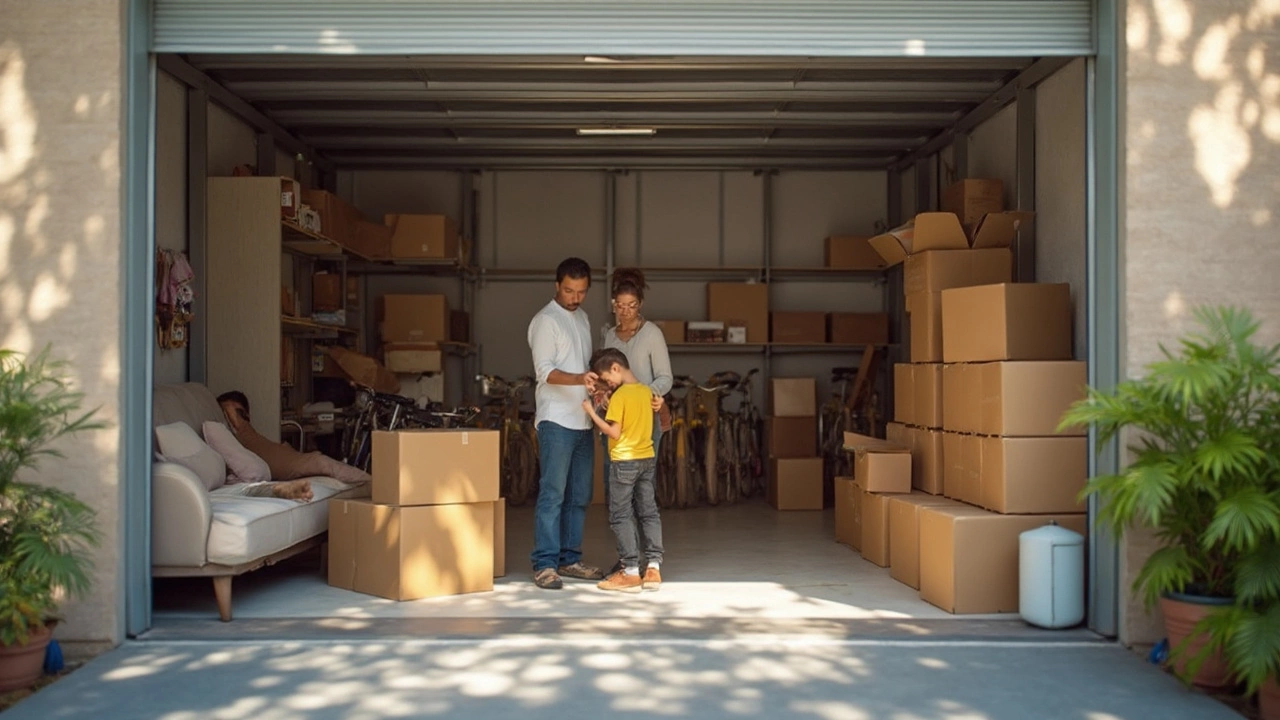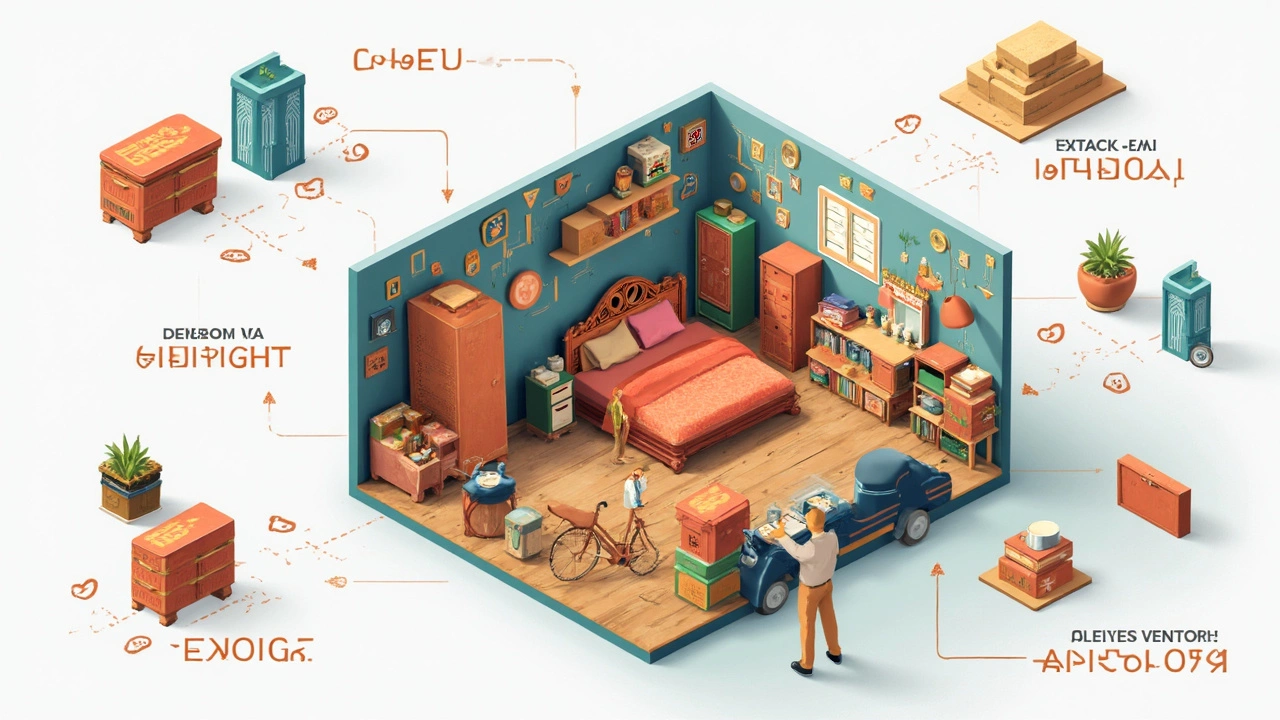How Many Rooms Fit in a 10x20 Storage Unit?

Ever looked at a 10x20 storage unit and wondered, "Could all my stuff fit in there?" You're not alone. Most people have a hard time picturing what actually fits in a 200 square foot rectangle.
Picture this: a 10x20 unit is about the size of a standard one-car garage. We're talking enough space to store the contents of a two or three-bedroom home, if you plan it right. Think bedrooms, living room, dining room, even big appliances like refrigerators or washers.
The trick is knowing what to bring and how to pack it. Stackable boxes, sturdy shelves, and using every inch of vertical space makes a world of difference. If you just toss everything in, you'll waste more room than you realize.
Wondering if your king-size bed, dresser, sofa, and stacks of moving boxes will all squeeze in? With some creative organizing, it's doable. But there are a few types of items and room layouts that fit better than others.
Before you start hauling furniture, let’s get into the nitty-gritty of what a 10x20 storage unit really handles—so you don’t end up shelling out for extra space you don’t need.
- 10x20 Storage Unit Basics
- What Fits: Room by Room
- Packing Smart: Maximize Space
- Real-Life Examples and Storage Hacks
- Mistakes to Avoid
10x20 Storage Unit Basics
If you haven’t seen one up close, a 10x20 storage unit is no small fry. It offers around 200 square feet of open floor space. That’s about the size of a standard one-car garage, which means you can actually pull a car in there if you needed to. But for most people, it’s all about storing home or business stuff—especially for those times when you’re moving, remodeling, or dealing with a sudden life change.
So, what can you actually fit in a 10x20 storage unit? Here’s the lowdown with some key numbers that help size things up:
- 200 sq ft of floor space
- Ceiling height usually ranges from 8 to 10 feet (so vertical stacking is fair game)
- Enough room for large furniture (sofas, beds, dining tables, dressers)
- Fits around 4-5 rooms’ worth of household items
- Works well for business inventory, equipment, or even motorcycles and ATVs
To give you a better sense, here’s a quick look at what those numbers mean:
| Item | Estimated Fit |
|---|---|
| Queen Beds | Up to 2-3 with frames |
| Dining Table + Chairs | 1 large table, 6-8 chairs |
| Standard Sofa | 2 full-size or sectional |
| Appliances (fridge, washer, dryer) | 2-3 big pieces |
| Packed Boxes | 40-50 medium boxes |
What makes the 10x20 storage unit shine is flexibility. People use these for storing the entire contents of a 2-3 bedroom house, office furniture, or bulkier seasonal items. You’ll need to be smart about packing, though. Stacking heavier stuff on the bottom and lighter boxes on top keeps things stable and helps use every inch.
One key tip: units on the ground floor offer drive-up access. That means you can pull up your truck and load big, heavy items without wrestling them through halls or elevators. If you expect lots of in-and-out visits, ask for a drive-up ground-level unit—they make a world of difference when moving things in and out.
If you’re still trying to measure things in your head, look at it this way: if you can fit it in a single car garage, you can fit it in a 10x20 storage unit. It’s a storage game-changer for anyone caught between places or just needing a lot of extra room.
What Fits: Room by Room
Walking into a 10x20 storage unit can feel like moving into a mini garage. But packing up your home beats guessing games. Here’s what actually fits, room by room.
Living Room: Most setups have a sofa (even a sectional), coffee table, a few chairs, TV stand, and maybe a bookshelf or two. Stack throw pillows and ottomans inside each other to save space. Break down larger furniture if possible—it’s way easier to Tetris in flat pieces.
Bedroom: For each bedroom, you’ll get a queen or king-size bed (frame, box spring, mattress), nightstands, a dresser, and a handful of storage bins or boxes. If you break down your bed frames and put boxes under tables or stacked upright, you’ll fit more. Most people manage to squeeze in two to three sets of bedroom furniture by staying organized.
Dining Room/Kitchen: Expect to fit a four- to six-seat dining table (legs off works best), chairs, maybe a sideboard, plus large appliances like refrigerators, washers, or dryers. Stack your smaller appliances or use them for packing extra belongings—think toaster oven stuffed with kitchen towels.
Garage/Basement: Bicycles, lawnmowers, grill, golf clubs, and even a stack of storage bins packed with holiday decorations can all go in. If you have tools or garden stuff, toss them in toolboxes or plastic totes first. Grouping similar-sized items makes the best use of the storage unit.
To help you picture it, here’s a quick breakdown in a table:
| Room | What Typically Fits |
|---|---|
| Living Room | Sectional sofa, recliner, coffee table, TV stand, 2-3 boxes |
| Bedroom x3 | Queen/king beds, dressers, nightstands, 8-10 boxes each |
| Dining/Kitchen | Table, 6 chairs, large appliances, 5-8 boxes |
| Garage/Basement | Bikes, grill, mower, bins, tools, seasonal gear |
One of the best tips: put less-used stuff in the back and whatever you might need soon up front. Label your boxes on more than one side so you don’t end up opening them all just to find your tools. If you’re storing business inventory, lines of shelves work wonders for holding dozens of labeled boxes. Keeping things easy to reach keeps your storage solutions stress-free.

Packing Smart: Maximize Space
Getting the most out of your 10x20 storage unit takes more than just dumping boxes inside. The secret is planning ahead and using every inch from the floor to the ceiling. Think of your unit as a giant Tetris game—every piece has a spot where it fits best.
Here’s what works in real life:
- Stack boxes by weight. Heavy stuff on the bottom, lighter things on top. Use same-size boxes for easy stacking and less wasted space. Save the funky-shaped cartons for soft things like bedding or clothes.
- Disassemble big furniture. Beds, tables, and bookshelves usually come apart. Bag up hardware and tape it to the biggest piece. This saves a ton of room and keeps things safer.
- Use the vertical space. Don't leave a foot of air between your stuff and the ceiling. Stand mattresses and sofas upright. If you have sturdy furniture, stack boxes or small items on them. Most units are about 8 feet high—use it all.
- Label everything. Sharpie directly onto boxes or use color-coded sticky notes. When you need to grab the winter clothes or grandma’s china, you won’t be tearing through every box you own.
Simple gear that boosts your space game: strong shelving, vacuum bags for puffy stuff, and plastic bins instead of saggy cardboard. Bins are easy to spot, move, and don’t collapse halfway through the summer.
Let’s look at how much you can actually pack in smartly. Here are some rough average stats:
| Item | How Many Fit |
|---|---|
| Queen mattress sets | 2-3 (upright) |
| Standard sofas | 1-2 (upright or flat) |
| Large appliances | 2-3 (refrigerator, washer, dryer) |
| Book boxes (medium) | 40-60 |
| Dining tables | 1 (disassembled) |
| Chairs | 6-8 (stacked/side) |
Tackle the unit by zone. Start at the back with stuff you won’t need for a while, then work your way forward with more essential or seasonal things. Make sure to leave an aisle. Nothing’s worse than crawling over a pile of boxes just to find your coffee maker.
Using these simple tactics, your storage solutions go from chaos to order. You’ll stretch those 200 square feet a lot further than you think.
Real-Life Examples and Storage Hacks
Here's where it gets real. Folks who rent a 10x20 storage unit are usually in the middle of a move, a remodel, or getting the house ready to sell. So, what can you actually fit in there? Let’s break it down with a couple of true-to-life examples.
One family stored the full contents of a typical three-bedroom house—beds, dressers, a sectional sofa, big TV, dining set, fridge, washer, and stacks of kids’ toys—inside their 10x20 storage unit. The key: they disassembled everything they could and stacked boxes to the ceiling along the back wall to free up floor space for larger furniture. Even the lawnmower fit in sideways by the door.
A small business owner I know used the same size for inventory and work equipment. He fit 18 large shelving units and over 50 labeled containers inside, all while leaving a walkable aisle down the center so he could grab items on the fly. He said vertical space was his best friend—tall shelving saved him from needing a bigger unit.
Want some hacks to stretch that square footage? Try these:
- Break down beds and tables so you’re only storing flat pieces—not bulky shapes that eat up space.
- Store mattresses upright along the wall, not flat on the ground. You’ll be amazed how much floor you free up.
- Pack boxes by weight: heavy on bottom, lighter on top, and all boxes labeled clearly on every side.
- Put couches and chairs on their ends or stack smaller chairs seat-to-seat—it saves inches.
- If you’re storing appliances, use them as storage space too. Fill the fridge or washer with pantry goods or linens in sealed bags.
- Leave an aisle down the middle. It sounds odd at first, but it prevents having to unpack everything to find your winter coat or that lost appliance cord.
To put it in perspective, here’s a quick look at how a packed 10x20 storage unit might break down:
| Item (Estimate) | Fit in a 10x20 Unit |
|---|---|
| Beds (King or Queen, disassembled) | 2-3 |
| Dressers/Nightstands | 4-5 |
| Sofas | 2 (or 1 sectional) |
| Dining Tables + Chairs | 1 set |
| Large Appliances | 3-4 |
| Standard Moving Boxes | 40-50 |
This isn’t magic—it’s just smart use of the room. The rule of thumb: if it fits in a one-car garage and you’re willing to spend a weekend organizing, you can probably make it work in a 10x20 storage unit. Organization and a little bit of patience go further than you think.

Mistakes to Avoid
It’s easy to think a 10x20 storage unit can take whatever you throw inside. But one of the biggest mistakes people make is wasting space. Throwing in boxes or furniture with no plan will eat up your square footage fast. You’ll end up paying for a unit that’s half-full just because you didn’t pack it right.
Another pitfall? Forgetting what you packed. If you don’t label every box, you’ll be digging through endless cardboard stacks, getting frustrated and losing track of essentials. Quick tip: make a detailed inventory and tape it inside the unit door.
Here’s a rundown of common storage slip-ups—and how to dodge them:
- Stacking too high, too soon: If you put heavy stuff on flimsy boxes, things collapse or tip, risking broken items and wasted space.
- No aisle or path: Packing tightly wall-to-wall locks you out from grabbing what you need later. Always leave a narrow walkway down the middle.
- Storing restricted or sensitive items: Don’t stash food, plants, or anything that can melt, mold, or attract pests. Most storage solutions have rules on what’s allowed anyway.
- Ignoring vertical space: Shelves aren’t just for home. Adding a simple shelf or stacking boxes neatly multiplies usable space—don’t just spread things on the floor.
- Not protecting furniture: Skipping mattress covers or plastic wrap means stains, dust, and scratches. Even in clean units, uncovered fabric soaks up odors over time.
Here's a peek at the most common packing blunders and their impact on available space, based on storage company surveys in 2024:
| Mistake | Average Space Wasted |
|---|---|
| No labeling | 10-15% |
| Improper stacking | 20% |
| No shelves used | 15-18% |
| No walkway | Up to 25% |
Smart packing is your best friend. Take a little time to plan and those square feet will go a lot further. Don’t get stuck upgrading to a bigger unit just because your packing game wasn’t up to snuff.